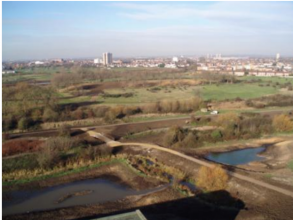Case study:Beam washlands
Project overview
| Status | Complete |
|---|---|
| Project web site | http://https://safag.org/wp-content/uploads/2020/07/19_Beam.pdf |
| Themes | Economic aspects, Flood risk management, Habitat and biodiversity, Hydromorphology, Monitoring, Social benefits |
| Country | England |
| Main contact forename | Becca |
| Main contact surname | O'Shea |
| Main contact user ID | |
| Contact organisation | Environment Agency |
| Contact organisation web site | http://www.gov.uk/government/organisations/environment-agency |
| Partner organisations | Arup, Design for London, Land Trust, London Borough of Barking and Dagenham, London Borough of Havering, Natural England |
| Parent multi-site project | |
| This is a parent project encompassing the following projects |
No |
Project summary
This multi-award winning partnership project built on a £4.5 million flood and coastal risk management (FCRM) scheme to improve the integrity and capacity of this flood storage washland, providing better protection to over 570 homes and businesses. The scheme provides a large, wildlife-rich, community parkland in one of east London's most deprived communities ((Map 1). This includes 12.6ha of Biodiversity Action Plan (BAP) habitat, 150m of remeandering on the Wantz Stream, 600m of reprofiling and 300m of in-channel features on the River Beam. The project was completed in 2012; maintenance is funded and delivered by partners.
Increasing the storage capacity of the existing washlands from 433,000m3 to 458,660m3 provides a standard of protection to downstream properties for (approximately) up to a 1 in 25 year flood event. The provision and operation of the pumping stations provides an enhanced standard of protection of up to 1 in 150 years. This reduces the risk of flooding to 570 homes and 90 businesses. The flood risk regulation benefits of undertaking this project provide a gross asset value of avoided flood damage benefits worth £591,000 per year compared with £193,000 per year before the scheme was constructed.
Socioeconomic/historic context Eftec (2015) states that: 'Beam Parklands is a multi-use community space and flood storage area situated in the south-east of the London Borough of Barking and Dagenham. The site lies on the borough boundary between Dagenham and South Hornchurch. Historically, the land has been used for a variety of different purposes. In the Victorian era, a smallpox isolation hospital was constructed on part of the site. However, for the majority of the 20th century, the site was open space and was eventually designated as part of the Green Belt to protect the openness of the corridor along the Beam River'. Before the recent flood risk management scheme discussed here, the majority of the land area (Beam Washlands) was owned and managed as a flood storage area by the Environment Agency. A smaller pocket of land was owned by the London Borough of Barking and Dagenham for use as park space. This was largely unmanaged with low levels of accessibility for some nearby communities, contributing to high levels of deprivation in the area, and subject to instances of antisocial behaviour.
Monitoring surveys and results
Increasing the storage capacity of the existing washlands from 433,000m3 to 458,660m3 provides a standard of protection to downstream properties for (approximately) up to a 1 in 25 year flood event. The
provision and operation of the pumping stations provides an enhanced standard of protection of up to 1 in 150 years. This reduces the risk of flooding to 570 homes and 90 businesses. The flood risk regulation benefits of undertaking this project provide a gross asset value of avoided flood damage benefits worth £591,000 per year compared with £193,000 per year before the scheme was constructed.
Lessons learnt
Image gallery
|
Catchment and subcatchment
Site
Project background
Cost for project phases
Reasons for river restoration
Measures
MonitoringHydromorphological quality elements
Biological quality elements
Physico-chemical quality elements
Any other monitoring, e.g. social, economic
Monitoring documents
Additional documents and videos
Additional links and references
Supplementary InformationEdit Supplementary Information
| ||||||||||||||||||||||||||||||||||||||||||||||||||||||||||||||||||||||||||||||||||||||||||||||||||||||||||||||||||||||||||||||||||||||||||||||||||||||||||||||||||||||||||||||||||

